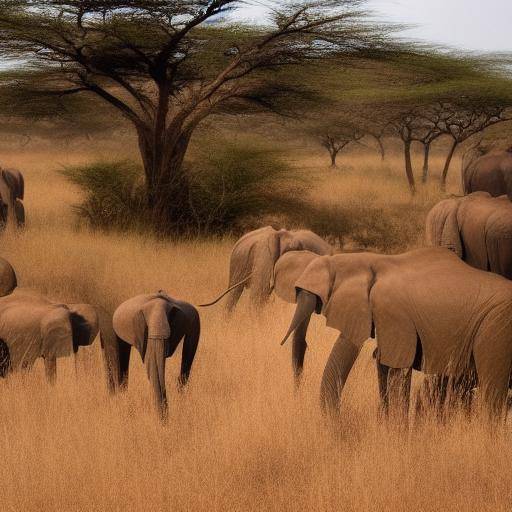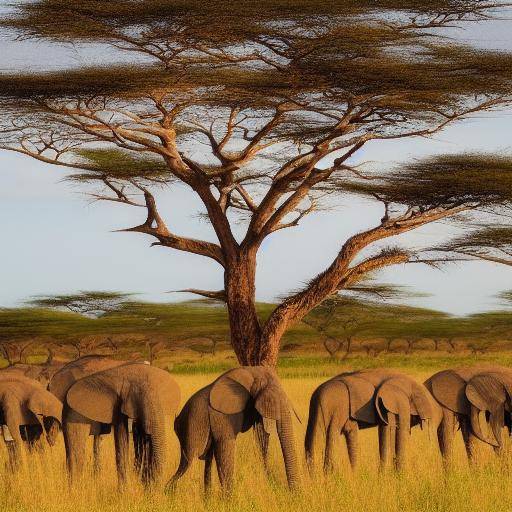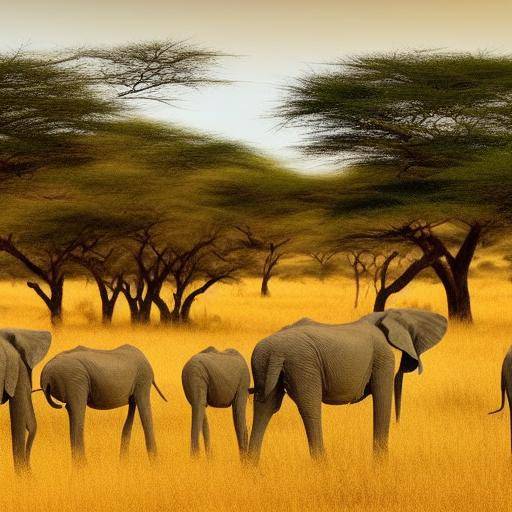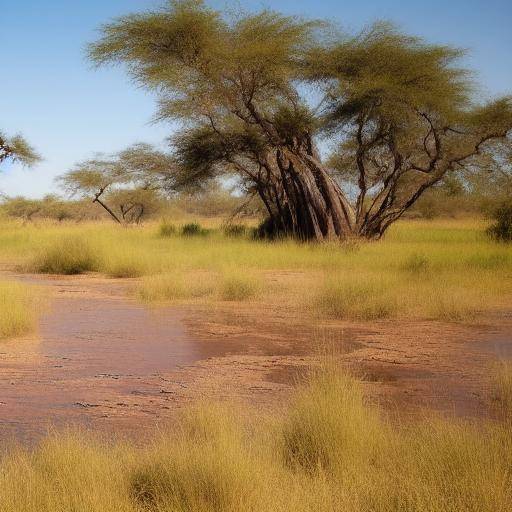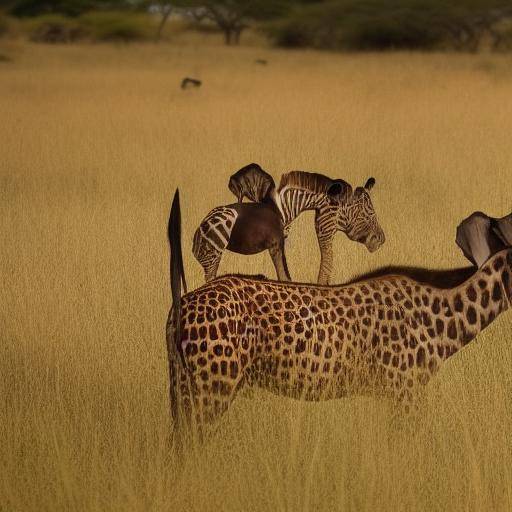
Photo safaris in Kenya have gained world fame for offering wildlife lovers the opportunity to witness and capture the beauty of African art in its purest form. From the majesty of the great felines to the grace of the elephants, Kenya is an incomparable destination for those seeking a unique experience in nature. In this article, we will explore the rich history of safaris in Kenya, the role of art in this unique experience, current challenges and trends, as well as practical advice for those who wish to embark on this adventure.
Introduction
With its extensive plains, majestic mountains and a rich diversity of wildlife, Kenya attracts photographers, adventurers and nature lovers from around the world. Photo safaris have become one of the most popular ways to experience first-hand wildlife, giving visitors the opportunity to witness and capture unforgettable moments through the lens of a camera.
In this article, we will explore how art intertwines with the experience of photographic safaris in Kenya, from the composition of a perfect image to the capture of the very essence of nature in its wildest state. Together with this, we will analyze the challenges and opportunities faced by photography lovers in the unique environment of Kenya and provide valuable advice to those who wish to embark on this adventure.
History and Background
The safaris in Kenya have their roots in hunting, a popular activity among European settlers who settled in Africa during the nineteenth and twentieth centuries. However, as the awareness of wildlife conservation grew, safaris evolved from hunting to wildlife observation and photography. In 1946, the Nairobi National Park was established as the first Kenyan national park, marking the formal start of wildlife tourism in the country.
The popularity of photo safaris in Kenya grew rapidly throughout the 20th century, attracting visitors from around the world with the promise of close encounters with some of the most iconic animals in Africa, such as lions, elephants, rhinoceros, buffaloes and leopards. At present, safaris in Kenya have become a key tourist industry for the country, providing vital income and support for wildlife conservation.
Deep analysis
The art of photography plays a crucial role in photo safaris in Kenya, as it allows visitors to capture the majesty and beauty of wildlife in their natural environment. The composition, enlightenment and patience are fundamental elements for obtaining shocking images that convey the unique essence of African nature. However, the art of photography in safaris also poses unique challenges, such as the control of exposure in changing light environments, the choice of appropriate equipment and the composition of moving images.
Comprehensive review
Photo safaris in Kenya offer visitors an incomparable experience to connect with nature and capture the beauty of African art through the lens. Photography enthusiasts have the opportunity to witness unique and fascinating moments, from the impressive luus and zebra migrations in the Masai Mara to the close encounters with the powerful rhinoceros in the Tsavo National Park. At the same time, they face challenges such as the need to adapt to unpredictable environments and the search for the perfect take in a dynamic environment.
Comparative analysis
Compared to other destinations, Kenya offers a unique combination of natural scenarios, diverse wildlife and the authenticity of African culture, which serves as an inexhaustible source of inspiration for photographers seeking to capture art in its purest form. The rich diversity of ethnic groups, traditional clothing, ceremonies and local artistic expressions provides an exceptional background for those who wish to explore art in its most authentic form.
Practical Tips and Accessible Tips
For those who want to embark on a photo safari in Kenya, it is important to be prepared to make the most of this unique experience. Some practical tips include choosing the right team, understanding the behaviors and routines of wildlife, the importance of patience and adaptability, as well as the need to always respect both nature and local communities.
Ideas of Experts and Industry Trends
Photo professionals have seen a change in the way photographic safaris are conceived in Kenya, with a growing focus on conservation, sustainability and respect for wildlife and local communities. This evolution reflects a broader change within the wildlife tourism industry, where the environmental and social impact of tourism activities is increasingly being considered and managed responsibly.
Case Studies and Practical Applications
Numerous case studies have been documented that illustrate the extraordinary artistic quality that can be achieved through photographic safaris in Kenya. From iconic images that have captured unique moments of wildlife to moving portraits of local culture, photography in Kenya has inspired world-renowned photographers, as well as enthusiasts and fans who seek to explore their creativity in a unique environment.
Future Trends and Predictions
The future of photo safaris in Kenya seems to focus on growing awareness of the importance of conservation and sustainability, as well as on the development of innovative approaches that integrate technology, education and community participation. The demand for authentic and respectful experiences with wildlife is expected to continue to grow, which will boost the evolution of photographic safaris towards a more conscious and committed practice.
Conclusion
Photo safaris in Kenya are much more than simple animal observation trips: they represent an opportunity to witness and capture the very essence of African art in its wildest form. With its rich history, incomparable biodiversity and the authenticity of its local culture, Kenya remains an exceptional destination for those who seek to immerse themselves in the beauty of nature and art in its purest state.
Frequently asked questions
What is the best time of the year for a photo safari in Kenya?
The optimal time to perform a photographic safari in Kenya generally coincides with the annual migration of luus and zebras in the Masai Mara, which occurs between July and October. During this period, you can witness extraordinary natural shows and capture unique images of wild life in motion.
What are the most common challenges facing photographers during a safari in Kenya?
Photographers often face challenges such as the variability of enlightenment, the unpredictable movement of wildlife and the need to adapt rapidly to changing environments. Choosing the right team and patience are key to overcoming these challenges.
How can photo safaris contribute to wildlife conservation in Kenya?
Photo safaris can contribute to wildlife conservation by raising awareness of the importance of protecting the natural environment and promoting responsible tourism practices. In addition, a portion of the income generated by tourism is devoted to community conservation and development programmes, which has a direct impact on the protection of wildlife and support for local communities.
What are the best locations in Kenya for photo safaris?
Kenya offers a variety of ideal destinations for photographic safaris, such as the Masai Mara, the National Park of Ambaseli, the Nakuru Lake National Park and the Samburu National Park, each with its own diversity of wildlife and unique landscapes that offer countless opportunities for photographic capture.
Is previous experience required in photography to enjoy a photo safari in Kenya?
It is not necessary to have previous experience in photography to enjoy a photographic safari in Kenya. Many tour operators offer safaris adapted to people of all skill levels, with expert guides that provide advice and support to participants, regardless of their photography experience.
What is the impact of tourism in Kenya on wildlife conservation?
Tourism plays a key role in wildlife conservation in Kenya by generating revenue for national parks and reserves, supporting the creation and maintenance of protected areas, and providing funds for community conservation and development programs that help protect the country's biodiversity.
What is the cultural importance of photo safaris in Kenya?
Photo safaris in Kenya not only offer the experience of wildlife, but also provide the opportunity to explore the rich local culture, including interaction with local communities, participation in cultural activities and learning about Kenya's authentic traditions and customs.
This comprehensive guide provides a profound and detailed view of the photographic safaris in Kenya and its role in the capture of African art in its purest form. From the history and evolution of safaris to the present challenges and opportunities, this article offers valuable knowledge for those who wish to explore the beauty of wildlife through the art of photography in Kenya's incomparable natural setting.

